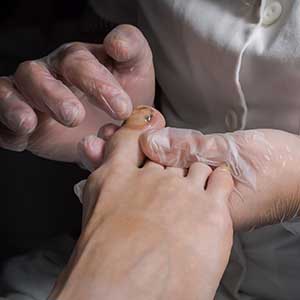Subungual Melanoma Overview
Also known as “nail unit melanoma,” subungual melanoma is a type of skin cancer that develops under the nails. More specifically, it occurs in the nail matrix, which is located at the base of the nail and is responsible for producing keratin.
Subungual melanoma is a relatively rare type of cancer, accounting for only 0.7% to 3.5% of all melanoma cases. Although this malignancy can develop in any of the fingernails and toenails, it most commonly affects the thumb and the big toe.
Causes and risk factors of subungual melanoma
As with other types of melanoma, subungual melanoma develops within melanocytes, which are responsible for producing melanin (skin pigment). Researchers are still working to determine exactly what causes this malignancy, although studies suggest that it could be associated with the increased production of melanin.
 Having one or more of the following risk factors can increase a person’s chances of developing subungual melanoma:
Having one or more of the following risk factors can increase a person’s chances of developing subungual melanoma:
- Being over age 50
- Having light hair, fair skin and/or freckles
- Having numerous moles
- Having a condition that weakens the immune system (for example, human immunodeficiency virus or HIV)
- Having a family history of melanoma or another type of skin cancer
- Having previously injured the affected nail
It’s important to note that, unlike certain other types of melanoma, subungual melanoma does not appear to be related to sun exposure.
Signs and symptoms of subungual melanoma
Subungual melanoma often produces a brown or black streak under the affected nail. It’s usually about 3 millimeters wide and may have an ill-defined border. Because this streak often resembles a bruise, it’s important to monitor how its appearance changes over time, especially if there was no known injury to the nail—a bruise will generally heal and move outward as the nail grows, while a streak caused by subungual melanoma will not heal or change positions (although it may grow larger).
Other common subungual melanoma symptoms include:
- Nail bleeding
- A thinned, cracked and/or distorted nail plate (the hard portion of the nail)
- Formation of an ulcer or nodule beneath the nail plate
- Separation of the nail plate from the nail bed (the skin below the nail plate)
- Pain in the nail bed
- Darkened skin next to the nail
- An extension of nail pigment into the adjacent skin (this is commonly known as “Hutchinson’s sign”)
Melanoma, in general, often metastasizes (spreads) relatively quickly to other areas of the body. And because subungual melanoma develops under the nails, it can be especially difficult to recognize the earliest signs of this malignancy. So, if you notice any of the subungual melanoma symptoms listed above, you should promptly consult with a trained medical provider.
Diagnosing subungual melanoma
When someone visits a physician about a potential case of subungual melanoma, the provider will likely begin by asking questions about the patient’s symptoms—for instance, when they began and whether they’ve changed at all over time—as well as questions about the patient’s personal and family medical histories. Then, they’ll perform a physical examination.
If the physician suspects that the patient might have subungual melanoma, they’ll likely order a biopsy—they’ll collect a tissue sample from the affected nail and send it to a pathologist, who will carefully examine the cells to determine whether they’re cancerous. If the biopsy confirms that the patient has subungual melanoma, the physician will likely order further testing to determine how far the malignancy has progressed and whether it’s metastasized to any other areas of the body.
Subungual melanoma treatment
Treatment for subungual melanoma will vary from one patient to another based on factors such as the stage of the cancer and the patient’s overall health. With that said, subungual melanoma treatment usually involves surgically removing the affected portion of the nail and/or digit. Surgery may be accompanied by radiation therapy, chemotherapy and/or immunotherapy to prevent or treat metastasis of the malignancy to other areas of the body.
The Moffitt Cancer Center difference for subungual melanoma
If you’re concerned that you might have subungual melanoma, you can turn to the experts at Moffitt Cancer Center. Our Cutaneous Oncology Program features a multispecialty team that excels at diagnosing and treating melanoma and other types of skin cancer, and our Donald A. Adam Melanoma and Skin Cancer Center of Excellence is working diligently to advance melanoma research, so you can trust that you’re in the best possible hands.
Contact Moffitt Cancer Center today to request an appointment—no referral is required. You can reach us by calling 1-888-663-3488 or filling out our new patient registration form online. We understand how important it is to move quickly with a potential subungual melanoma diagnosis, so we’ll be sure to put you in touch with a cancer expert as soon as possible.
References
Canadian Dermatology Association: Subungual Melanoma
Healthgrades: All You Need to Know About Subungual Melanoma
Medical News Today: What to Know About Subungual Melanoma
National Center for Biotechnology Information: Subungual Melanoma
Types
